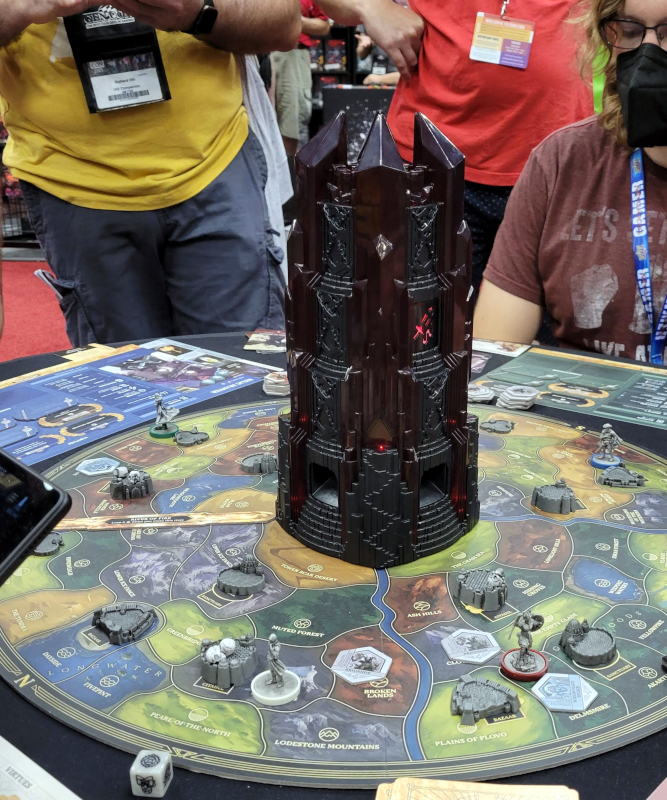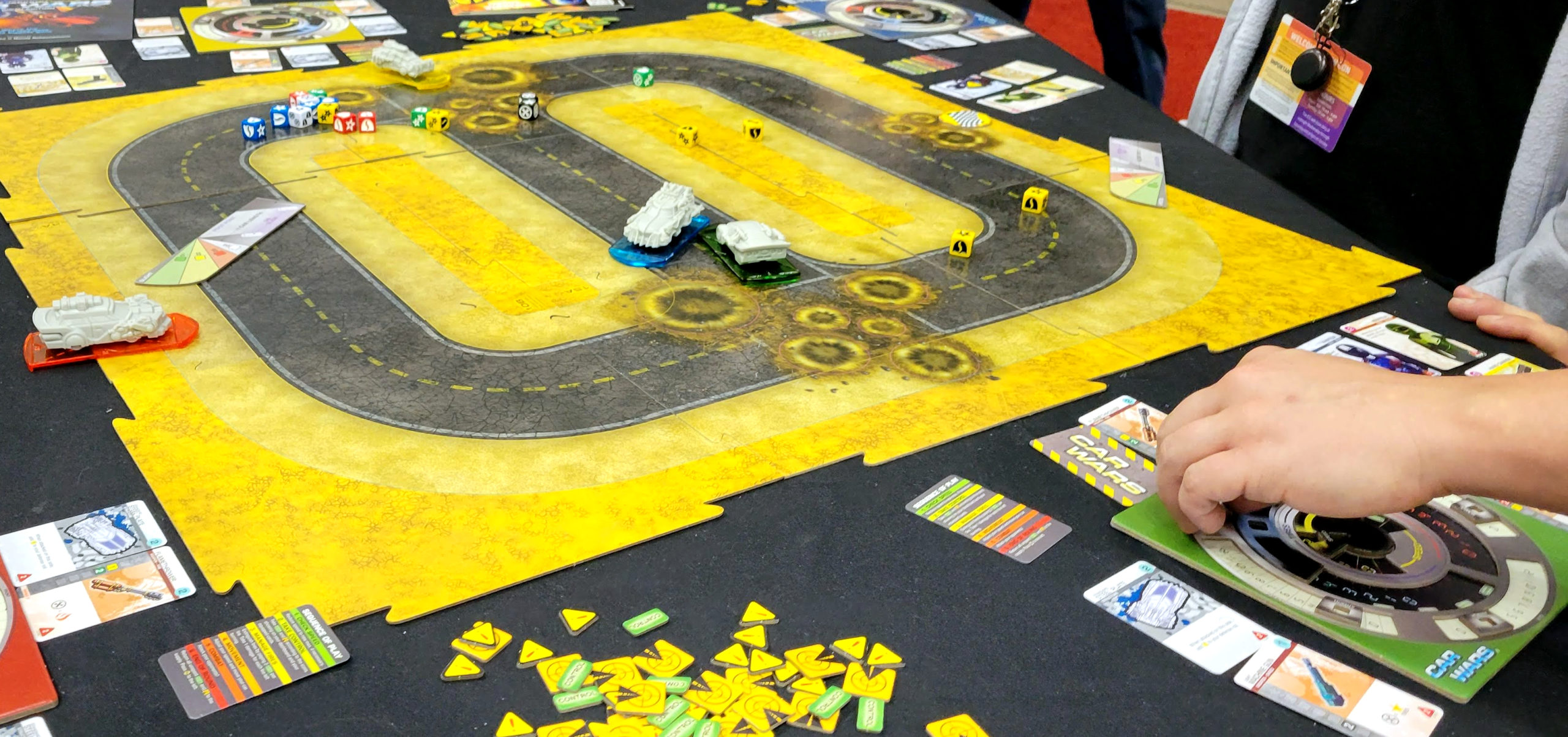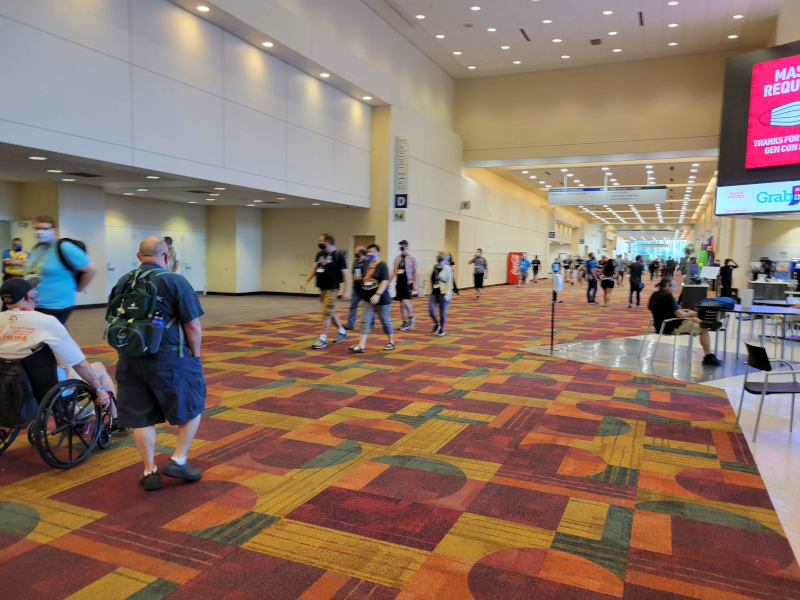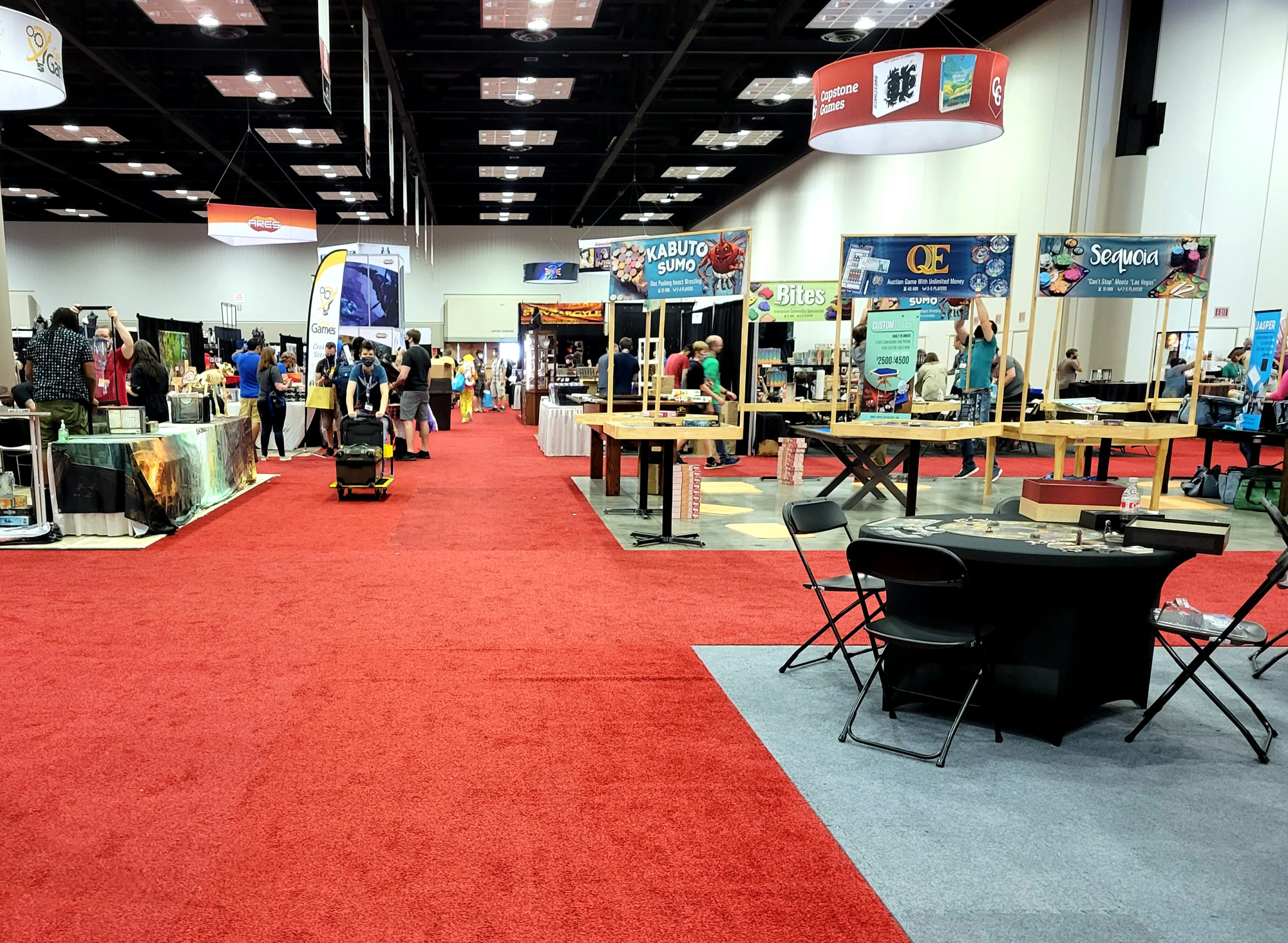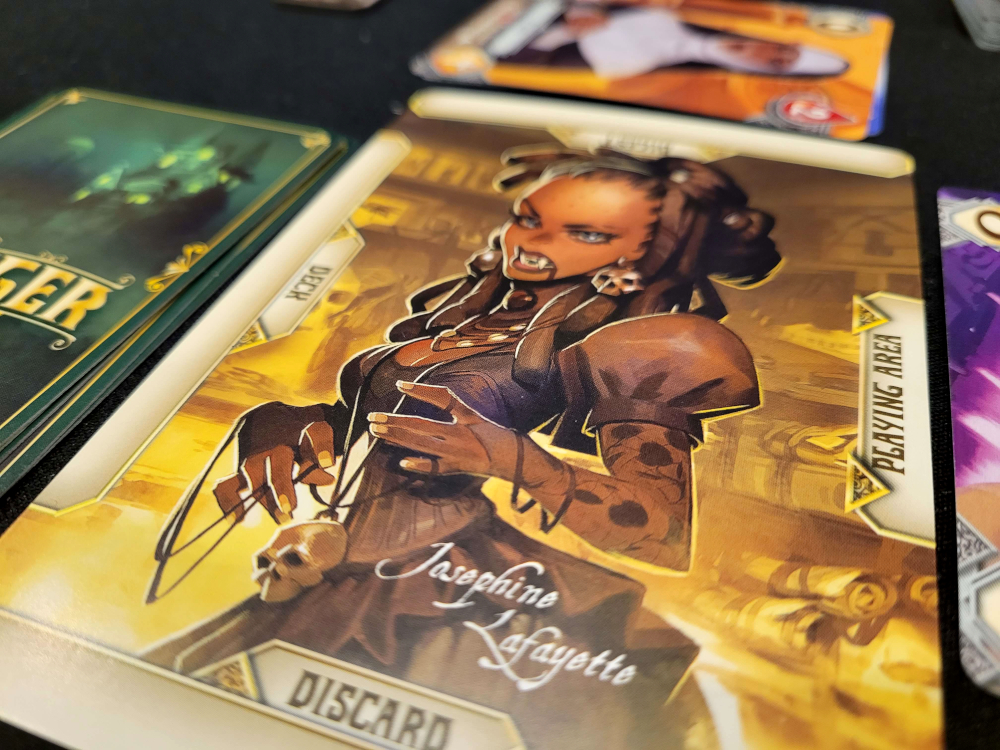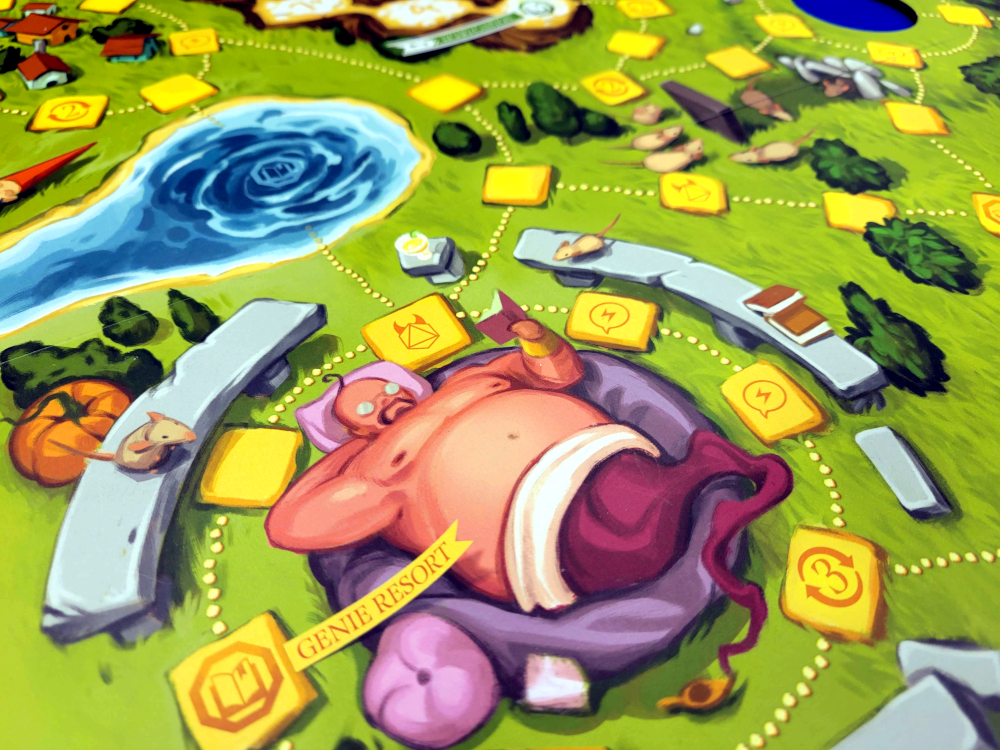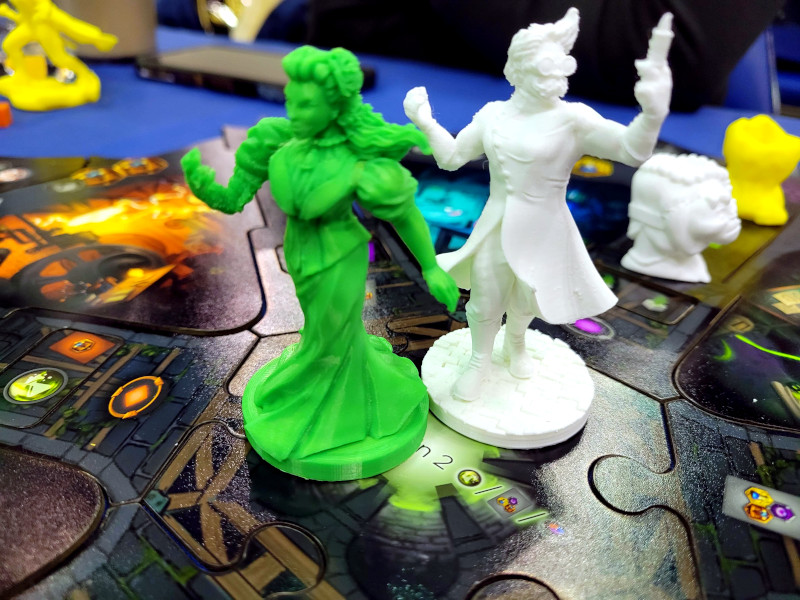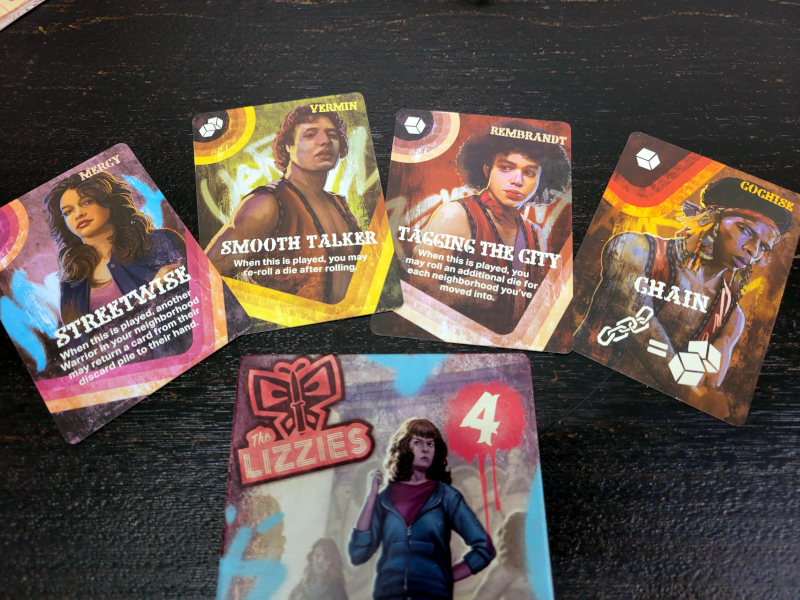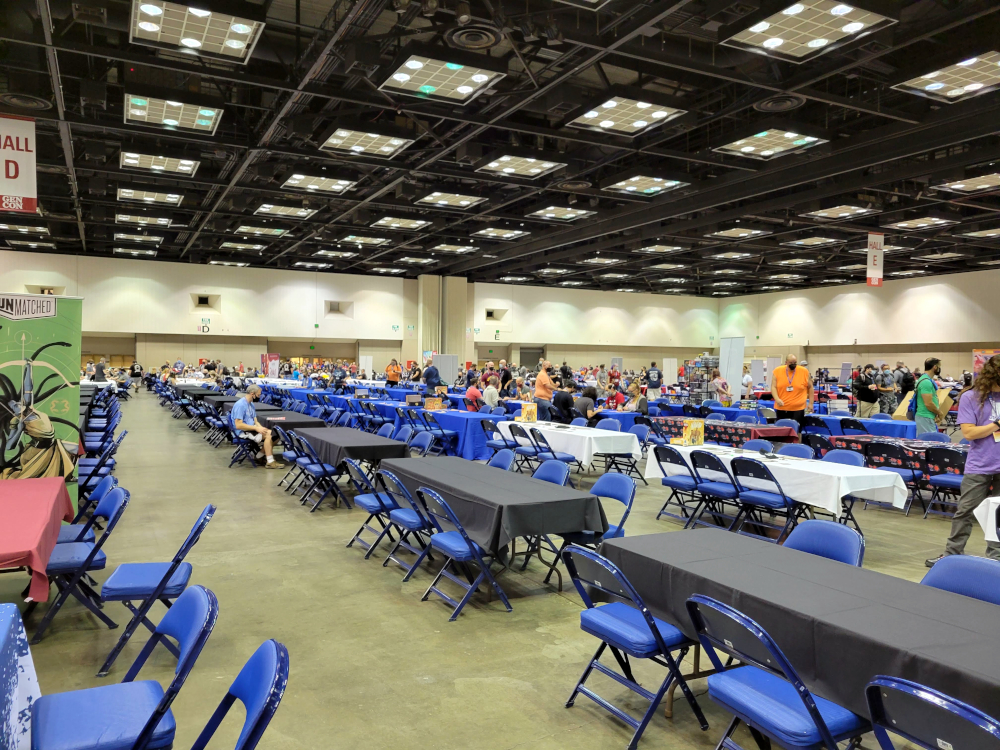“Hello old friend.” These were the words I silently uttered upon entering the Indianapolis Convention Center on Wednesday afternoon to retrieve my badge for Gen Con 2021. After more than 18 months of uncertainty, of conventions canceled, conventions un-canceled but moved online, of conventions shuffled around the calendar with the same haphazard detachment as one does trying to organize a family get-together; of bad news, no news, and being perpetually stuck to the social sidelines, I genuinely wasn’t sure what to feel when setting foot into a game convention – let alone what is typically the largest in North America. Frankly, I wasn’t sure if I would feel anything. It has been more than two years since “the best four days in gaming” took place, and a lot had changed in the interim.
I would say that I attended Gen Con as usual, but this time was anything but usual. Typically Gen Con is a buzzing hive of analog activity with a panoply of gamers from all across the world descending on Indianapolis at the height of midsummer to immerse themselves in the convention’s massive, sprawling array of games and general celebration of tabletop enjoyment.
The experience instead this time around was at once a remarkable return to form while remaining slightly surreal and somewhat subdued. Gen Con 2019 boasted a staggering attendance of nearly 70,000 people, the effects and repercussions of which were palpable within the halls of the convention center and rippled throughout the entire city’s downtown as the typically accommodating Indianapolis strained under record attendance and the convention’s own success.
Gen Con 2021 saw numbers approximately half that, dropping the convention’s attendance to rates not seen in a decade. This was all by design, of course, a sensible precaution in a world that has denied us a great many things, including a normal Gen Con last year entirely, due to the effects of the global pandemic.
Said pandemic, however, is far from over. Thanks to stubbornly high rates of unvaccinated in the country, trepidation (or out-right restrictions) over international travel, and a surge COVID’s Delta variant that only now seems to be cresting, the US continues to collectively grapple with stemming the tide of COVID-19 spread. Indiana’s state ranking is just south of the vaccination median at around 56% for people 12+, which doesn’t particularly instill a sense of pride – especially for someone such as myself coming from the relatively safer New England where comparative numbers are the highest in the country. (New Hampshire notwithstanding. Because New Hampshire.)
With that reality in mind, Gen Con workshopped several plans throughout the summer before settling on an imposed mask mandate for anyone under the convention center’s roof. Most attendees spoken to would have preferred the convention gone further and required proof of vaccination or negative-test requirements – something even the organizers tacitly acknowledged ahead of time while simultaneously admitting it was too late in the process to implement. This desire came despite the self-selected responders of a leadup poll putting the vaccination rate of exhibitors and attendees around 90%.
Yet while all of this amounts to a prudent understanding why many this year opted to sit this one out, to simply assume every attendee was couching some kind of bravado-fueled invective about being overly cautious would be a disservice.
So, then, what was Gen Con like?
I pondered this question significantly on the extensive ride home, deciding that there were ultimately two paths one could take.
The first angle would undoubtedly scan well on social media – a morality tale about risking injure to oneself or others over something as recklessly frivolous as a board game convention. With so many souls lost to this disease the world over, is this the event you’re willing to literally roll the dice on? Is any humdrum social activity for that matter?
After all, what could be so worth venturing out for in such circumstances? Gen Con’s famously cavernous expo hall was much diminished this year, a reduction in booth numbers north of 33%. Many of the biggest publishers in the hobby were largely absent, including KOSMOS, Paizo Publishing, Privateer Press, Rio Grande Games, and the entire Asmodee fleet. (There strangely was, however, an explicably large eBay booth if you really wanted to bid on some high-end CCG cards.) The odds of many grand announcements were minimal. The oft-cherished annual Fantasy Flight announcements were presented online. Many of the larger panels, ancillary hands-on activities, and evening events at nearby restaurants were bound to be negligible. Most of the more than 200 “new” games in BGG’s preview listing had already been released earlier this summer or likely wouldn’t be available for months anyway due to the ongoing freight nightmare afflicting the entire industry.
Yet here people had come by the thousands to roll up a character sheet they could do over Zoom, to cosplay in a hallway instead of Instagram, to take the annual pilgrimage to the cardboard cathedral that is Gen Con despite evidence showing that audiences would still gravitate to new games without the pomp and circumstance of a convention. But why? Between Tabletopia, Twitch, Zoom, and a bazillion publisher Discords, you could make board gaming work online until it was completely safe again to game with strangers. The last 18 months demonstrated that heading out into such an environment was as pointless as it was unnecessary. You really don’t need to buy that comedic t-shirt, leather journal, or discounted copy of Power Grid in person with the internet at your fingertips. The old cons are dead. Long live the virtual con.
I could have taken that morality angle, and it undoubtedly could have found a home in online places that reward anger and absolutism, despair and pessimism. Places that would bemoan the poor individuals who had little other choice to be there and to chastise the rest from afar for going to such an event merely for a few fist bumps and to partake in a litany of unimportant, benign convention rituals.
I could have, except doing so does a great injury to the larger tale at work. One that is much truer to the experience of those who were there.
Don’t get me wrong: I’m not saying that the execution was perfect, and it would be easy to rip into Gen Con on those points. Gen Con’s inability to implement a vaccination requirement stemmed solely from changing their minds on protocol several times throughout the summer more than some dystopian fiat from the city or state, and there seemed to be little enforcement, if any, regarding people bringing unmasked and unvaccinated small children to such an environment – both of which were particularly maddening.
However, Gen Con did make ample changes that made it starkly different under the conditions we all found ourselves. The convention center installed new air filtration, and hand sanitizer was everywhere. Within the ICC masks were on at all times the vast, vast majority of the time, excepting a handful of tables in specific locations for eating food. The deep booming play halls typically full of games and available 24 hours a day padded extra spacing between many of the tables, and the entire operation kicked everyone out by midnight each night for cleaning, precluding the time-honored traditions of seeing hallway Werewolf underway well into the early morning or the occasional but inevitable over-extended attendee to have slept the night away in his chair in Hall D.
The expo hall was likewise changed. Without the grand tents of some of the largest publishers and the drive for the newest AAA titles, the beating heart of Gen Con was paradoxically both smaller and more spacious. Exhibitor booths were given more room to operate and the aisles in between were significantly widened to increase social distancing and facilitate better air flow – in some cases as wide as the physical carpet roll would allow. The wider walking space was particularly welcomed, especially by some with mobility issues, and it would be wonderful to see as a permanent change – even if it means stealing space elsewhere. The end result was that people were rarely clustered together. Even the traditionally jam-packed Saturdays were navigable without much consternation.
In other words, while it’s easy to hold up a snapshot on Twitter of the few minutes each morning when people did marshal near the expo doors and decry the entire enterprise as wanton irresponsibility, inevitably put forth with an air of self-assured righteous indignation, these brief few moments in time (and brief they were) are nowhere near an accurate encapsulation of what actually transpired on the ground.
Gen Con 2021 was spacious. It was more low-key. It was more personal. And it was enjoyable in part because it was refreshingly benign and pointless.
Whether by feature or byproduct, this year’s convention felt less dispassionate and more down to earth than any I recall of the past decade – so much so that at times it didn’t feel like “Gen Con” at all. Some of this can naturally be attributed to the lower attendance of both exhibitor and gamer, but there also existed a prevailing undercurrent of emotion throughout those present. An element that so many of us had taken for granted our entire lives until forcibly removed by a rapacious and unrelenting disease. A precept so instinctually embedded within the core of our accumulated experiences and fundamentally understood by all of us from the earliest stages of life: humans need one another. Like food and water and shelter we thrive on physical, social interaction. While each of our individual needs to that end vary significantly, to ask people to forgo interaction entirely for too long brings with it very real ramifications. Just as prolonged sleep deprivation can have damaging impacts on one’s physical health, extended isolation brings with it consequences on one’s physical and mental health. We all have spent more than a year and half trying to supplement this need to communicate via technology and distraction, but these efforts are a mere stopgap to address the sense of prolonged isolation, emptiness, and listlessness – not a panacea.
Laughter over FaceTime is not the same as if they are in the room with you. An online conversation is devoid of the nuances and mannerisms when one speaks, the inflection and tone of one’s voice, and the silent nonverbal cues accompanying a statement cluing you in as to just how serious or not to take it. The honest to goodness joy of simply goofing around with someone nearby for no real reason, or my god, just to wander aimlessly through it all simply because you can. Technical innovations are marvelous, but we cannot escape our need for physical interaction forever. Among the Gen Con attendees, it was palpable how many people had been missing, even craving this long-deprived social normalcy – particularly around those with a likeminded interest such as gaming. Just as board games are quintessentially a social enterprise, conventions thrive because they are in-person social events, and dismissing them merely as places to exchange goods and information is a profound injustice to the more intangible qualities they offer.
That being said, there certainly was an ample exchange of goods at this year’s Gen Con. Board gamers are renown for a willingness to spend money; this year doubly so. People came primed and ready to purchase, which led almost to ‘a tale of two conventions’ type show for exhibitors. If you were a publisher putting out a new game of the last 6-9 months, especially a vaunted Gen Con debut, odds were high you sold through most or even all of the product you brought. This was compounded by the fact that many publishers really weren’t sure what to expect and tended to err conservatively on how much to bring. (There were, of course, exceptions.) Numerous publishers remarked by the end that not only did they sell out of their allocated game stock but that they had experienced one of their most profitable Gen Cons in years. On the other hand, if you only had older or evergreen titles sales were much more modest. As a traditionally high marquee event in the annual board game release cycle and comprised of heavily of enfranchised hobby gamers, Gen Con generally tends to focus on gobbling up newer rather than existing titles, so this sort of outcome isn’t shocking. What was, however, was just how quickly much of it flew off the shelves.
All of which is why, in spite of the perils, Gen Con writ large was wonderfully upbeat. Despite the masks and restrictions, people were genuinely happy to be there. Part of that was for the games, yes, but part of it was also just to see one another. Most attending Gen Con were not blind to the circumstances surrounding them, nor were they ignorant or belligerent about the conditions they were in the thick of. Person after person I asked acknowledged that this year’s convention was weird, surreal even, and most couldn’t believe two years had passed. And yet, strange as it sounds, it also felt refreshingly normal. For the first time in two years people were able to congregate over board games in Indianapolis. Happy, even knowing that the situation wasn’t ideal. Happy because the factors surrounding its operation indirectly put those meaningful interactions between people front and center.
In many ways the reduced numbers and smaller scale actually did attendees a favor, reminding them that magic behind tabletop gaming isn’t the game itself but being able to enjoy it with the people across the table from you. They chose to go with full recognition of the situation before them, partly over the chance to rekindle that sense of shared geekery and partly to reclaim a missing facet from their lives. The pandemic is still very real, and many still expressed motes of nervousness to varying degree, but most who went found the convention to be rejuvenating to their spirits, a relief to their psyche, and calming – yes calming – to their state of mind. All as if the temperature, for a brief moment in their lives, had been turned way down.
A bit ironic given the circumstances? Perhaps. But also indelibly linked.
None of this is to say there won’t be ramifications to this choice. While attendees inside the convention center were mostly vaccinated and almost entirely masked, once into the nearby hotels and downtown establishments mask usage realistically dropped to about half. Per Marion County ordinances, you didn’t need to wear a mask indoors if vaccinated, though there was no way to validate one’s claim. Statistically this means the chances of some cases, breakthrough or otherwise, are not zero, especially when factoring in that Gen Con ran concurrently with several other smaller downtown events and a stadium-packed NFL football game that Sunday. What can only be hoped is that any such cases are both rare and mild.
Nor is a physical convention necessarily ideal for everyone under the best of situations, as even with a reduced footprint the pandemic has shed light on the less perfect aspects of a convention. For all of the faults of living in a Zoom-centric limbo over the last 18 months, interacting digitally has allowed some members of the gaming community to participate in the hobby in ways they might not have been able to otherwise to in person due to geographic location, disability, or financial limitations. For non-drinkers, fewer offsite evening events and late night gatherings at this year’s con substantially curtailed social pressures to visit bars as part of industry festivities. The explosion of online activities provide viable alternate options of engagement, reducing the in-person chances of many in the community from being subjected to hateful commentary, being sexually harassed, or worse. As safe, inclusive, and welcoming as such events strive to be, game conventions are not immune from unwanted behavior and require constant vigilance. Laudable progress has been made at several cons in recent years, but these advancements were borne out of demands for enforcement and accountability of those proscribed ideals. This is evidenced by the fact that there were two individuals removed this year at Gen Con, including the head of TGG games for undisclosed reasons (though likely stemming from recent online behavior) and another individual working at a booth who recently has been accused of predatory behavior and sexual assault.
There were wholly valid reasons to skip this year’s Gen Con, and indeed there was little collective desire for derisiveness or dismissiveness towards anyone who sat this year out. Each person has their own comfort level, and there existed a universally understood, if unspoken, sentiment that it will take time for each person to bring themselves to trust being in public again. To being around people again. And, ultimately, the necessity of forging a new baseline regarding how much risk tolerance you’re willing to undertake in order to achieve social interaction again. As it becomes increasingly likely that COVID-19 is on the path towards becoming more endemic than epidemic, each of us is currently figuring out what level of risk they find acceptable amidst a sea of constantly changing variables and along a spectrum ranging from willfully flouting any precautions to refusing to engage at all until eradication. Which, potentially, could mean never.
Gen Con 2021 was undoubtedly a strange event, and like most attendees one I did not carelessly decide to partake in without coming to terms with those aforementioned risks. Yet the two words I inexorably keep returning to in describing my time there were “weird”, yes, but also “uplifting”. Despite the risks, it’s undeniable how energizing and restorative attending this year was – which I’m well aware is a perplexing sentiment to use for a convention where so many names and faces I’ve come to cherish there over the years were absent and where it’s almost inevitable someone will end up with COVID. It’s all the more strange given that the other through-line experienced across four days was just exactly how bad the global shipping mess is affecting the board game industry.
But I wasn’t alone in that sentiment. Far from it. From GMs and miniatures skirmishers to First Exposure playtesters and one vendor after another, there was an unmistakable solidarity not just in the want to come back, but the need to. A very human need. As one publisher put it, “It’s good to be home. It’s not quite how we left it, but it’s home all the same.”
It’s that optimistic paean that encapsulates why, for those who took the leap, Gen Con this year was perhaps more memorable than any other. It was a year where the games and dice and player screens were mere window dressing for something deeper and more meaningful. Amidst the interminable hell of the pandemic itself, the transience of time due to being locked away for months on end, and the collective emotional anguish expressed online, it’s easy to forget that distancing and masks and vaccines aren’t just an effort to save lives – paramount though they are in that goal. They’re also a reminder of what we are fighting tooth and nail to reclaim: to meet and gather and rejoice together once more. Even for something as completely, totally, wonderfully banal as a celebration of tabletop gaming.
Also See:
- Part 1 – A Foreword: Conventioning During COVID
- Part 2 – Active Crowdfunding Projects
- Part 3 – The New Hotness
- Part 4 – The Surprise Hits
- Part 5 – News & Announcements
- Part 6 – What Comes Next

